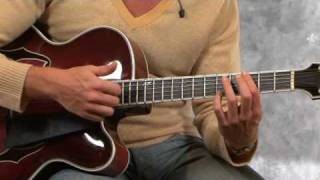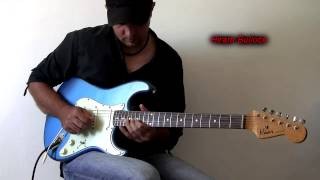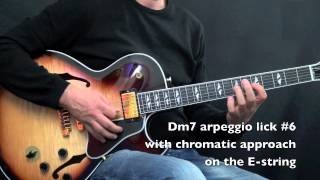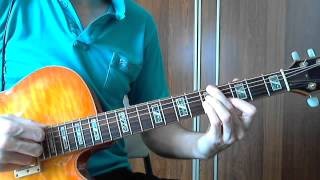ii V I chord progression exercise part 3
Published on 26 January 2016
Jazz chord exercise with ii V I progression round circle of fourths. Guitar lesson about improvising over ii V I progressions. 2 5 1 chords and how to use them.
From the Secret Guitar Teacher: http://secretguitarteacher.com/youtube/ssb.php?lp_id=947
Here is the video script:
There are numerous approaches to improvising over 251 sequences, but a great way to really get orientated to this is to start by using arpeggios.
Let's simply play round our testbed using the arpeggios of the basic chords in root position, played eight notes to the bar like this. For the Minor 7th arpeggio start with your first finger on the root so you can reach the flat 3rd with your pinky the 5th with your 3rd finger and the flat 7th with your first finger.
To complete the bar we then play the arpeggio descending starting with the 3rd finger on the root octave note and coming back down exactly the way we went up via the flatted 7th, 5th and minor third. But from that flat 3rd, don't try to complete the arpeggio by playing the root again because we have already used up our eight notes so it's time for the root note of the next chord which we want to play with our second finger here on the fifth string straight across from our first root note because remember we are following the circle of fourths. This is a dominant seventh chord so we follow the formula 1 3 5 b7
and then descending from the root octave in the same manner as the last chord.
Now we make a bit of a jump down to fret ten for our key note, D in this case which we again want to nail with our second finger to enable us to play the Maj7 arpeggio 1 3 5 7 and descending 8 7 5 3. This time we do go back to the root because we are going to repeat this for the fourth bar of the sequence.
So here is the whole of that 2 5 1 in D major again in slow motion.
I advise practicing that a few times just like that until it becomes fairly automatic. Do make absolutely sure you follow the same fingering pattern each time - it doesn't have to be the same fingering as mine - your fingers might be a completely different size to mine - but whichever pattern you settle on, stick to it.
Once you have that down, simply play through it once then switch to playing the minor 7th arpeggio on the same root as you just used to play the maj 7th.
Making sure you also switch to the first finger for the root note then you follow exactly the same root around the 251 in C major... switch fingers again and on into the 251 in Bb.. and so on.
Below the screen you should find a backing track to go with this lesson. Once you have practiced this for a while on your own, have a go at playing along to that track all the way round the circle of fourths a few times.
At this stage I think it is important to resist the temptation to start improvising. It's a good idea to get orientated to these basic arpeggio patterns played completely straight, before starting to mess about with them, otherwise you are likely to get hopelessly lost very quickly and that soon becomes frustrating!
So I am going to leave you to practice that and test yourself against the backing track. In the next sound bite in this series, I'll pass on a few tips about using this drill as a basis for improvising.
 Minor II V I - Kurt Rosenwinkel #1
Minor II V I - Kurt Rosenwinkel #1
 Jazz Guitar Lessons with Andreas Oberg: Harmonics
Jazz Guitar Lessons with Andreas Oberg: Harmonics
 II V I - Mike Moreno #3 ã€ÂModern Jazz Guitari...
II V I - Mike Moreno #3 ã€ÂModern Jazz Guitari...
 25 Jazz Fusion Licks (Free lesson / TABS) - TheGui...
25 Jazz Fusion Licks (Free lesson / TABS) - TheGui...
 II V I - Pat Metheny #3 ã€ÂJazz Guitar LessonÃ...
II V I - Pat Metheny #3 ã€ÂJazz Guitar LessonÃ...
 How to Improvise - Basics Part 1 - Achim Kohl, Jaz...
How to Improvise - Basics Part 1 - Achim Kohl, Jaz...
 DARN THAT DREAM - Jazz Guitar LESSON - Chord Melod...
DARN THAT DREAM - Jazz Guitar LESSON - Chord Melod...
 HOW HIGH THE MOON - Guitar LESSON - Chord Melody T...
HOW HIGH THE MOON - Guitar LESSON - Chord Melody T...
 Autumn Leaves part 2 (jazz guitar comping lesson)
Autumn Leaves part 2 (jazz guitar comping lesson)
 Jazz Guitar Comping - Bossa Nova Rhythm - Lesson E...
Jazz Guitar Comping - Bossa Nova Rhythm - Lesson E...







